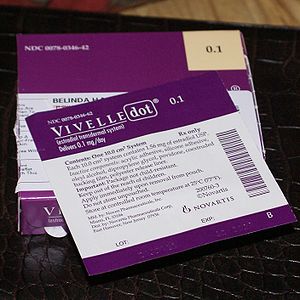 Image via WikipediaThe process of "reproductive aging" begins around age 40. There are declining levels of the hormones estrogen and progesterone. These hormones maintain the health of the vagina and uterus, and they regulate menstrual cycles.
Image via WikipediaThe process of "reproductive aging" begins around age 40. There are declining levels of the hormones estrogen and progesterone. These hormones maintain the health of the vagina and uterus, and they regulate menstrual cycles.Menopausal transition, called "perimenopause," is when a woman's body is close to menopause. Perimenopause usually begins about 2-4 years before the last menstrual period. It ends when menopause begins.
A woman reaches menopause when a year has passed since her last period.
Menopause symptoms include changes in periods such as intervals and flow rates, hot flashes and night sweats, vaginal dryness and thinning of bones.
To help control menopause symptoms like hot flashes, night sweats , mood swings, etc. a doctor might suggest taking estrogen and progesterone, known as hormone therapy (HT) or hormone replacement therapy (HRT). The most comprehensive evidence about taking hormones after menopause comes from the Women's Health Initiative Hormone Program sponsored by the National Heart, Lung and Blood Institute and the National Cancer Institute.
Findings of studies
The WHI Hormone Program involved two studies — the use of estrogen plus progestin (a synthetic progesterone) and the use of estrogen alone. Women who have undergone a hysterectomy are generally given estrogen alone. Women who have not undergone this surgery are given estrogen plus progestin, which have a lower risk of causing cancer of the endometrium, the lining of the uterus.
The estrogen/progestin study was stopped in 2002, when investigators reported that the overall risks outweighed the benefits. The estrogen-alone study was stopped in 2004, when the researchers concluded that estrogen alone increased the risk of stroke and blood clots.
The following are some additional findings from the WHI program about the risks of taking hormone therapy:
Some pro's and some con's . It is important to discuss HRT with your doctor to determine whether it is right for you. As for me, I'll probably stick with my hot flash pajamas.

1 comment:
Hi friend! I want to say that this article is awesome,great written and include approximately all important infos.I would like to look more posts like this
Tahsin
Bio identical hormones
Post a Comment